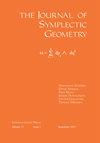论交映组的 GIT 商、周期轨道的稳定性和分岔(着眼于实际应用)
IF 0.4
3区 数学
Q3 MATHEMATICS
引用次数: 0
摘要
在本文中,我们将介绍一系列旨在研究哈密尔顿系统周期轨道、其(线性)稳定性及其分岔的工具。我们将为反交错渐开线保留的机械系统(如圆受限三体问题)提供对称轨道的轨道圆柱体存在的拓扑障碍。这种圆柱体诱导的连续路径不与适当的交映组 GIT 商的分岔位置相交,而交映组 GIT 商是分支流形,其拓扑学提供了所需的障碍。也就是说,相应位置的补集由我们列举并明确描述的几个连通部分组成;根据构造,这些部分不能由轨道圆柱体诱导的路径连接。我们还为每个规则和奇异成分提供了优选的正常形式。我们进一步引入了对称轨道的签名概念,它扩展了克林理论(只适用于椭圆轨道)的概念,使之也适用于双曲对称轨道的情况。这一特征有助于预测在对称轨道的哪些点会出现分岔。这为研究对称轨道的稳定性和分岔问题提供了一个总体理论框架,以期在空间飞行任务设计的背景下进行实际的数值计算。这是后续论文$href{https://doi.org/10.1007/978-3-319-72278-8}{[7]}$的主题,其中这一框架得到了数值工作的支持。本文章由计算机程序翻译,如有差异,请以英文原文为准。
On GIT quotients of the symplectic group, stability and bifurcations of periodic orbits (with a view towards practical applications)
In this article, we will introduce a collection of tools aimed at studying periodic orbits of Hamiltonian systems, their (linear) stability, and their bifurcations. We will provide topological obstructions to the existence of orbit cylinders of symmetric orbits, for mechanical systems preserved by anti-symplectic involutions (e.g. the circular restricted three-body problem). Such cylinders induce continuous paths which do not cross the bifurcation locus of suitable GIT quotients of the symplectic group, which are branched manifolds whose topology provide the desired obstructions. Namely, the complement of the corresponding loci consist of several connected components which we enumerate and explicitly describe; by construction these cannot be joined by a path induced by an orbit cylinder. We also provide preferred normal forms for each regular and singular component. We further introduce a notion of signature for symmetric orbits, which extends the notion from Krein theory (which only applies for elliptic orbits), to allow also for the case of symmetric orbits which are hyperbolic. This signature helps predict at which points of a symmetric orbit a bifurcation arises. This gives a general theoretical framework for the study of stability and bifurcations of symmetric orbits, with a view towards practical and numerical implementations within the context of space mission design. This is the subject of the follow-up paper $\href{https://doi.org/10.1007/978-3-319-72278-8}{[7]}$, where this framework is supported by numerical work.
求助全文
通过发布文献求助,成功后即可免费获取论文全文。
去求助
来源期刊
CiteScore
1.30
自引率
0.00%
发文量
0
审稿时长
>12 weeks
期刊介绍:
Publishes high quality papers on all aspects of symplectic geometry, with its deep roots in mathematics, going back to Huygens’ study of optics and to the Hamilton Jacobi formulation of mechanics. Nearly all branches of mathematics are treated, including many parts of dynamical systems, representation theory, combinatorics, packing problems, algebraic geometry, and differential topology.

 求助内容:
求助内容: 应助结果提醒方式:
应助结果提醒方式:


